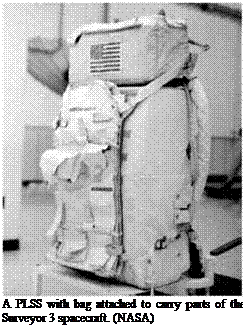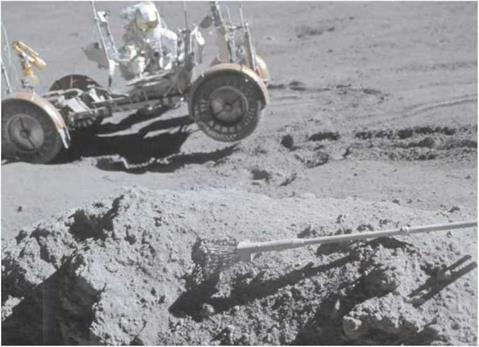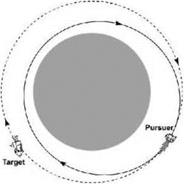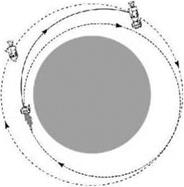Apollo missions were always timed to arrive at their planned landing sites soon after sunrise and therefore close to the terminator the line that divides night from day. If the mission had been planned to set down on the eastern side of the Moon’s disk then, from Earth, the Moon would appear as a crescent at the time of landing because the sunrise tenninator would also be to the east. Л western landing site called for a western terminator, at which time the Moon would appear gibbous, or approaching full. In all cases, the spacecraft flew’ over a night-time Moon soon after it lost contact with Earth in the run up to LOI.
Apollo 8 pioneered human travel to the Moon. Its crew’ did not intend to land, but were to reconnoitre an easterly landing site in Mare Tranquillitatis under planned lighting conditions. The flight was limed to have the sunrise terminator near their target which meant that most of the illuminated surface was on the far side. Having approached through ihc lunar night, they could hope to cross the sunset terminator and fly back into daylight around the far side barely five minutes before they were to fire the LOI burn. Frank Borman peered out of a rear-lacing spacecraft, hoping to see some sign of a lunar horizon in order to crosscheck his attitude, even if only by seeing a part of the sky that lacked stars.
“On that horizon, boy. I can’t see squat out there."
Bill Anders suggested that they turn some lights off to help him to see some trace of the lunar surface. As they w’ere flying heads-dowm. their large windows were looking off to the side and below and even though they were fogged, a sunlit lunar surface ought to have been visible. Then Lovell, looking through the hatch window’, piped up: “Hey. I got ihc Moon."
For the first time in the mission, the crew could see shafts of sunlight obliquely illuminating the lunar surface.
"Do you?" asked Anders.
"Right below’ us."
When Anders managed to catch his first view of the forbidding, harsh landscape, he expressed his astonishment. "Oh, my God!"
His commander, wlio was focused on the preparations for the burn, was brought up short by this most uncharacteristic of utterances for a test pilot.
"What’s wrong?" he demanded.
"Look at that!" Anders exclaimed again. But his commander w as more concerned that, at this critical phase of the mission, his crew mates had become distracted by the unreal scenery passing below’.
"Well, come on," said Borman, working to bring the crew back onto the task in hand. "Let’s – What’s, what’s the…" Lovell immediately got into line, calling out the mission time.
"69:06"
"Stand by." commanded Borman. "We’re all set."
For the next minute, the crew’s concentration returned to the cheeks and calls defined in their checklists. Yet with three minutes remaining, Anders’s attention returned to the scenery below’. "Look at that fantastic!"
"Yes," confirmed Lovell.
"See it?" continued Anders. The curious scientist in him was dominating.
"Fantastic, but you know. I still have trouble telling the holes from the bumps."
Borman, whose main responsibility was to ‘keep the troops focused’, had to gently chide his crcwmatcs to keep their eyes inside the cabin.
‘‘All right, all right, come on. You’re going to look at that for a long time."
And they did, while circling the Moon ten times over a period of 20 full and tiring hours prior to the crucial burn that would get them home.
The Apollo 10 crew experienced the same dynamic when LMP Eugene Cernan had opportunities to see out w hile his commander Tom Stafford and the CMP John Young exchanged checklist calls.
"Look at the size of..he exclaimed in the middle of his colleagues’ dry technical checks. "God, that Moon is beautiful; we’re right on top of it…”
"Oh shit!" wfas Stafford’s reaction. Cernan continued. "God dang. We’re right on top of it. I can see it.’’
Stafford began telling Young what was out of his window on the left. "Oh. shit; John! It looks like a big plaster-of-paris cast.”
With less than two minutes to their LOI burn. Stafford’s sense of responsibility reasserted itself. "Ok. let’s get busy," he called to his crew.
For some time, their procedures took precedence until Cernan’s curiosity bubbled up again. "My God. that’s incredible." he said in w’onderment as the very rough, obliquely-lit landscape of the far side slid below.
"It looks like we’re close.” said Stafford.
"That’s incredible,’’ interrupted Cernan.
"It does look like we’re – well, we’re about 60 [nautical] miles, I guess.”
And they w’ere. With only a minute to go. the spacecraft was at its perilune of 110 kilometres and Stafford and Cernan were again getting caught up in the view’.
"Shit, baby; we have arrived – It’s a big grey plaster-of-paris thing…”
"Oh, my God, that’s incredible," Cernan interjected.
"Okay, let’s keep going; we’ve got to watch this bear here,” said Stafford, referring to the strength of the engine about to keep them in the Moon’s arms. Eventually, it w’as the ever-cool Young w’ho reeled the moonstruck Cernan back in.
"Put your head back in the cockpit. Genc-o.”
"Look at that!” was the final spurt of wonder that came from Cernan before he settled dow’n to monitor the health of the engine on which their lives depended.
Each crew’ reacted differently to their initial view’ of the Moon. Apollo ll’s crew’ were very focused during their preparations for LOI, making little comment on anything but the health of their ship until the last few seconds before the burn. Then Mike Collins, the most gregarious of the three, threw in an observation: "Yes, the Moon is there, boy, in all its splendour.’’
Neil Armstrong started into conversation. "Man, it’s a…,” before Collins interrupted, "Plaster-of-paris grey to me.’’
Buzz Aldrin felt moved to speak. "Man, look at it,” he said before Armstrong, maintaining the mantle of his command, advised, "Don’t look at it; here we come up to Tig [time of ignition].”
Apollo 11 began its entry into lunar orbit and the crew’ chatted about tank pressures, propellant utilisation and how much their engine w’as moving from side to side as it controlled its aim which prompted them to wonder whether there might be a problem with it. After the burn’s successful conclusion, they concentrated on the follow-up activities; power-down, backing out of the armed status of the SPS engine and setting up the spacecraft for coasting flight again. Only then did any of them relax enough to take in the scene. Armstrong was first to comment; "That was a beautiful burn.’’
Collins agreed, "God damn. I guess."
"Whoo!" exhaled Aldrin. before making an initial window observation. "Well, I have to vote with the [Apollo] 10 crew. That thing is brown."
There had been some debate and contradiction between the first two flights about what colour the Moon appeared to be close up. The Apollo 8 crew had reported nothing but grey, whereas the Apollo 10 crew thought that tans and browns were common. Armstrong and Collins agreed with them but took their observations further.
"Looks tan to me," observed the commander before Aldrin qualified himself.
"But when I first saw it, at the other sun angle.. .”
"It looked grey." interjected Collins.
".. .it really looked grey," Aldrin concurred.
The last word goes to John Young when he arrived at the Moon for the second time on Apollo 16. Soon after their first AOS, Young described his crewmates’ reaction to the scenery: "It’s like three guys, they’ve each got a window, and we’re staring at the ground. Boy. this has got to be the neatest way to make a living anybody’s ever invented.”











 "Pete, let me reach back here and grab this strap.” The strap was part of a bag attached to the rear of Conrad’s PLSS that was to carry parts from the Surveyor 3 probe they were about to visit. Bean realised that in the weak gravity, he could use this to lower his commander to the surface without Conrad having to bend his knees.
"Pete, let me reach back here and grab this strap.” The strap was part of a bag attached to the rear of Conrad’s PLSS that was to carry parts from the Surveyor 3 probe they were about to visit. Bean realised that in the weak gravity, he could use this to lower his commander to the surface without Conrad having to bend his knees.

 Earth, taking only an hour and a half to go around at a linear speed of 7.8 kilometres per second. Geostationary satellites, which are the mainstay of global communications and television satellite broadcasting, orbit 35,800 kilometres above Earth’s equator, take 24 hours to get around once and travel at only 3.1 kilometres per second.
Earth, taking only an hour and a half to go around at a linear speed of 7.8 kilometres per second. Geostationary satellites, which are the mainstay of global communications and television satellite broadcasting, orbit 35,800 kilometres above Earth’s equator, take 24 hours to get around once and travel at only 3.1 kilometres per second. against the direction of travel, as if trying to get away from the target. We said it was counter-intuitive. The burn will cause the pursuer to fall into a lower orbit, which will have a shorter period and a higher linear speed. This will allow it to catch up with the target. The difficulty lies in choosing the exact moment to start climbing back into the original orbit, which we shall deal with later.
against the direction of travel, as if trying to get away from the target. We said it was counter-intuitive. The burn will cause the pursuer to fall into a lower orbit, which will have a shorter period and a higher linear speed. This will allow it to catch up with the target. The difficulty lies in choosing the exact moment to start climbing back into the original orbit, which we shall deal with later. The reverse is also true. If the pursuer is ahead in the orbit, it can ‘slow down’ by accelerating forward, which causes it to rise to a higher and therefore slower orbit. It can then drop down again when the target has caught up.
The reverse is also true. If the pursuer is ahead in the orbit, it can ‘slow down’ by accelerating forward, which causes it to rise to a higher and therefore slower orbit. It can then drop down again when the target has caught up. The concept of changing from one orbit to another is a common requirement in spaceflight and is embodied by our second principle which we have already met in Chapter 4 as the Hohmann transfer orbit. It is the most efficient and simplest way to change an orbit whereby firing a spacecraft’s engine along the direction of motion at one point in the orbit will increase its speed and thereby raise the altitude that will be reached on the opposite side of the orbit. Firing against orbital motion will slow the spacecraft and lower the altitude of the opposite side of the orbit. Control of the total impulse from the burn allows control of the altitude that will be reached at the opposite side. We have met this already in the way the CSM and LM made burns around the Moon’s far side to raise and lower their near-side altitude.
The concept of changing from one orbit to another is a common requirement in spaceflight and is embodied by our second principle which we have already met in Chapter 4 as the Hohmann transfer orbit. It is the most efficient and simplest way to change an orbit whereby firing a spacecraft’s engine along the direction of motion at one point in the orbit will increase its speed and thereby raise the altitude that will be reached on the opposite side of the orbit. Firing against orbital motion will slow the spacecraft and lower the altitude of the opposite side of the orbit. Control of the total impulse from the burn allows control of the altitude that will be reached at the opposite side. We have met this already in the way the CSM and LM made burns around the Moon’s far side to raise and lower their near-side altitude.